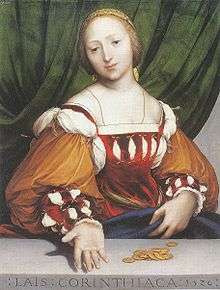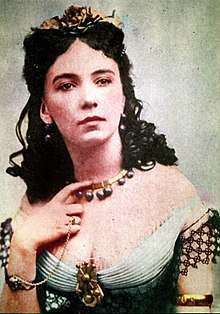Courtesan
A courtesan, in modern usage, is a euphemism meaning a sugar baby, escort, concubine, mistress or a prostitute, for whom the art of dignified etiquette is the means of attracting wealthy, powerful, or influential clients. The term originally meant a courtier, a person who attends the court of a monarch or other powerful person.[1]
Relationships (Outline) |
|---|
|
Endings |
In feudal society, the court was the centre of government as well as the residence of the monarch, and social and political life were often completely mixed together. Prior to the Renaissance, courtesans served to convey information to visiting dignitaries, when servants could not be trusted. In Renaissance Europe, courtiers played an extremely important role in upper-class society. As it was customary during this time for royal couples to lead separate lives—commonly marrying simply to preserve bloodlines and to secure political alliances—men and women would often seek gratification and companionship from people living at court. In fact, the verb 'to court' originally meant "to be or reside at court", and later came to mean "to behave as a courtier" and then 'courtship', or "to pay amorous attention to somebody".[1] The most intimate companion of a ruler was called the ”favourite”.
In Renaissance usage, the Italian word cortigiana, feminine of cortigiano ("courtier") came to refer to a person who attends the court, and then to a well-educated and independent woman, eventually a trained artist or artisan of dance and singing, especially one associated with wealthy, powerful, or upper-class society who was given luxuries and status in exchange for entertainment and companionship.[2] The word was borrowed by English from Italian through the French form courtisane during the 16th century, especially associated to the meaning of donna di palazzo.[1]
A male figure comparable to the courtesan was the Italian cicisbeo, the French chevalier servant, the Spanish cortejo or estrecho.
The courtesans of East Asia, particularly those of the Japanese empire, held a different social role than that of their European counterparts. Examples of Japanese courtesans included the oiran class, who were more focused on the aspect of entertainment than European courtesans.[3]
Categories
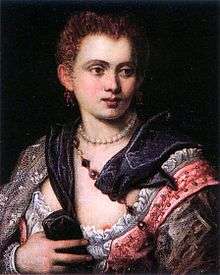
One type of courtesan was known (in Italy) as the cortigiana onesta, or the honest courtesan, who was cast as an intellectual. Another was the cortigiana di lume, a lower class of courtesan. The former was the sort most often romanticized and treated more-or-less equal to women of the nobility. It is with this type of courtesan that the art of "courtisanerie" is best associated.
The cortigiane oneste were usually well-educated and worldly (sometimes even more so than the average upper-class woman), and often held simultaneous careers as performers or artists. They were typically chosen on the basis of their "breeding"—social and conversational skills, intelligence, common-sense, and companionship—as well as their physical attributes. It was usually their wit and personality that set them apart from regular women. Sex constituted only a facet of the courtesan's array of services. For example, they were well-dressed and ready to engage and participate in a variety of topics ranging from art to music to politics.
In some cases, courtesans were from well-to-do backgrounds, and were even married—but to husbands lower on the social ladder than their clients. In these cases, their relationships with those of high social status had the potential to improve their spouses' status—and so, more often than not, the husband was aware of his wife's profession and dealings.[4]
Differences in status
As primary employment
Courtesans from non-wealthy backgrounds provided charming companionship for extended periods, no matter what their own feelings or commitments might have been at the time, and sometimes had to be prepared to do so on short notice. They were also subject to lower social status, and often religious disapproval, because of the immoral aspects of their profession and their reliance upon courtisanerie as a primary source of income. In cases like this, a courtesan was solely dependent on her benefactor or benefactors financially, making her vulnerable; Cora Pearl is a good example.
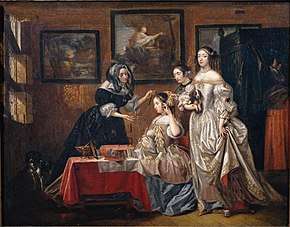
Often, courtesans serving in this capacity began their career as a prostitute, although many came to the profession by other means. It was not uncommon for a courtesan to enter into an arranged long-term liaison by contract with a wealthy benefactor. These contracts were written up by and witnessed by lawyers, and were binding. Most included some provision for the financial welfare of the courtesan beyond the end of the relationship in the form of an annuity. Many such women became so powerful socially and financially that they could be particular about the men they associated with; in other words they chose their paramour as would any other mistress, not the other way around. Wealthy benefactors would go to great lengths to court a courtesan as a prize, the ultimate goal being a long-term contract as a mistress.
Occasionally courtesans were passed from one benefactor to another, thereby resulting in them being viewed in society circles as lower than both their benefactor and those of wealth and power with whom they would socialize. Often, in instances of this sort, if the courtesan had satisfactorily served a benefactor, that benefactor would, when ending the affair, pass them on to another benefactor of wealth as a favor to the courtesan, or set them up in an arranged marriage to a semi-wealthy benefactor. In the event that the courtesan had angered or dissatisfied a benefactor, they would often find themselves cast out of wealthy circles, returning more often than not to street prostitution.
For social or political benefits
- Should not be confused with a royal mistress
Those from wealthy backgrounds, either by birth or marriage, and who were acting as courtesans only for the social or political advancement of themselves and/or their spouses were generally treated as equals. They were more respected by their extramarital companions, both placing one another's family obligations ahead of the relationship and planning their own liaisons or social engagements around the lovers' marital obligations.
Affairs of this sort would often be short-lived, ending when either the courtesan or the courtesan's spouse received the status or political position desired, or when the benefactor chose the company of another courtesan, and compensated the former companion financially. In instances like this, it was often viewed simply as a business agreement by both parties involved. The benefactor was aware of the political or social favors expected by the courtesan, the courtesan was aware of the price expected from them for those favors being carried out, and the two met one another's demands.
This was generally a safe affair, as both the benefactor's spouse and the courtesan's spouse usually were fully aware of the arrangement, and the courtesan was not solely dependent on the benefactor. It, rather, was simply an affair of benefits gained for both those involved. Publicly and socially, affairs of this sort were common during the 17th, 18th and 19th centuries, as well as the early 20th century, and were generally accepted in wealthy circles.[4]
Career length
In later centuries, from the mid-18th century on, courtesans would often find themselves cast aside by their benefactors, but the days of public execution or imprisonment based on their promiscuous lifestyle were over. There are many examples of courtesans who, by remaining discreet and respectful to their benefactors, were able to extend their careers into or past middle age and retire financially secure; Catherine Walters is a good example. By the late 19th century, and for a brief period in the early 20th century, courtesans had reached a level of social acceptance in many circles and settings, often even to the extent of becoming a friend and confidant to the wife of their benefactor.[4]
More often than not, a woman serving as a courtesan would last in that field only as long as she could prove herself useful to her companion, or companions. This, of course, excludes those who served as courtesans but who were already married into high society. When referring to those who made their service as a courtesan as their main source of income, success was based solely on financial management and longevity. Many climbed through the ranks of royalty, serving as mistress to lesser nobles first, eventually reaching the role of (unofficial) mistress to a king or prince.
Pietro Aretino, an Italian Renaissance writer, wrote a series of dialogues (Capricciosi ragionamenti) in which a mother teaches her daughter what options are available to women and how to be an effective courtesan. The French novelist Balzac wrote about a courtesan in his Splendeurs et misères des courtisanes (1838–47). Emile Zola likewise wrote a novel, Nana (1880), about a courtesan in nineteenth-century France.
Famous courtesans in history
The below list contains examples of professional courtesans. They are not to be confused with royal mistresses, except in the case when a professional courtesan was also a royal mistress.
17th century and before
- Amrapali (5th century BC), nagarvadhu-courtesan of Vaishali, following the Buddha's teachings she became an arahant.
- Lais of Corinth (5th century BC), hetaira-courtesan
- Aspasia (469 BC-409 BC), lover of the Athenian statesman Pericles
- Lais of Hyccara (killed 340 BC), hetaira-courtesan
- Thaïs (4th century BC), hetaira-courtesan
- Phryne (4th century BC), hetaira-courtesan
- Diaochan (born 169 AD), the lover of warlord Dong Zhuo and warrior Lü Bu during the Chinese Three Kingdoms
- Praecia (fl. 73 BC), Roman courtesan
- Volumnia Cytheris (1st century BC), Roman mimae actress and courtesan
- Su Xiaoxiao (late 5th century), Yiji-courtesan
- Theodora (6th century) (c. 500–June 28, 548), Byzantine actress-courtesan, later wife of Emperor Justinian I of the Byzantine Empire
- Li Ye (d. 784), Chinese Yiji-courtesan and poet
- ‘Inān bint ‘Abd-Allāh (Arabic: عِنان, d. 841), qiyan-courtesan
- Arib al-Ma'muniyya (Arabic: عَرِيب المأمونية, CE 797-890), qiyan-courtesan
- Shāriyah (Arabic: شارِية, c. 815-870 CE), qiyan-courtesan
- Fadl Ashsha'ira (Arabic: فضل الشاعرة, d. 871 CE), qiyan-courtesan
- Li Shishi (1062-1127), Chinese courtesan, regularly employed by Emperor Huizong of Song
- Kanhopatra (15th-century) Indian Marathi saint-poet and courtesan
- Yu Gam-dong (15th-century), Korean Gisaeng-courtesan
- Imperia Cognati (1486-1512), courtesan of Renaissance Rome, referred to as the "first courtesan" in Europe
- Tullia d'Aragona (c. 1510–1556): top courtesan in several Italian cities, and published poet
- Hwang Jin-i (fl. 1550): legendary gisaeng- courtesan of the Joseon Dynasty
- Veronica Franco (1546–1591): a Venetian cortigiana onesta courtesan who was once lover to King Henry III of France and was depicted in the movie Dangerous Beauty
- Anarkali (17th-century) courtesan of Salim (later Mughal emperor Jahangir)
- Marion Delorme (circa 1613–1650): lover of George Villiers, Duke of Buckingham, the Prince of Condé, and Cardinal Richelieu
- Ninon de l'Enclos (1615–1705): lover of the Prince of Condé and Gaspard de Coligny
- Chen Yuanyuan (1624–1681), Chinese Yiji-courtesan, one of the famous Eight Beauties of Qinhuai.
- Takao II (高尾, 1640 – 1659), Japanese oiran-courtesan
18th and 19th centuries
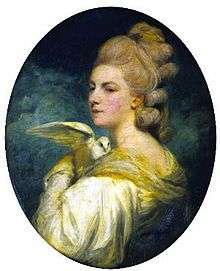
- Claudine Alexandrine Guérin de Tencin (1681–1749), French courtesan and later a famous salonniére
- Josefa Ordóñez (1728 – d. after 1792), Mexican courtesan-actress
- Kitty Fisher (died 1767), British courtesan and model
- Marie-Louise O'Murphy (1737–1814), French courtesan, lover but not official royal mistress of Louis XV of France
- Mary Nesbitt (1742-1825), British courtesan and spy
- Sophia Baddeley (1745–1786), British courtesan
- Støvlet-Cathrine (1745–1805), Danish courtesan, lover but not official royal mistress of King Christian VII of Denmark
- Rosalie Duthé (1748–1830), French courtesan, has been called "the first officially recorded dumb blonde".
- Grace Elliott (1754?–1823), British courtesan
- Charlotte Slottsberg (1760–1800), Swedish courtesan-ballerina, lover but not official royal mistress of Charles XIII of Sweden
- Dorothy Jordan (1761–1816), British courtesan-actress
- Mah Laqa Bai (7 April 1768 – August 1824), Indian tawaif-courtesan
- Harriette Wilson (1786–1846), British courtesan
- La Païva (1819–1884), French demimonde-courtesan ('Grande Horisontale') of the Second Empire
- Lola Montez (1821–1861), internationally famous courtesan, mistress to the king of Bavaria
- Marie Duplessis (1824–1847), French courtesan, one of the best known from the era of Louis Philippe
- Cora Pearl (1836–1886), demimonde-courtesan ('Grande Horisontale') of the Second Empire
- Eliza Lynch (1835–1886), British courtesan, de facto wife of Francisco Solano López, president of Paraguay
- Catherine Walters (1839–1920), British courtesan
- Blanche d'Antigny (1840–1874), French courtesan; Émile Zola used her as the principal model for his novel Nana
- Binodini Dasi (1862–1941), Indian courtesan-actress
- La Belle Otero (1868–1965), Spanish courtesan
- Liane de Pougy (1869–1950), French courtesan and Folies Bergère-dancer
- Sai Jinhua (1872–1936), Chinese courtesan
- Mata Hari (1876–1917), courtesan and spy
In addition to the list above, the term "courtesan" has often been used in a political context in an attempt to damage the reputation of a powerful woman, or disparage her importance. Because of this, there is still much historical debate over whether certain women in history can be referred to as courtesans. For example, the title was applied to the Byzantine empress Theodora, who had started life as an erotic actress but later became the wife of the Emperor Justinian and, after her death, an Orthodox saint. The term has also been applied to influential women including Anne Boleyn, Umrao Jaan, Madaline Bishop, Diane de Poitiers, Mathilde Kschessinska, Pamela Harriman, Eva Perón and Gabrielle "Coco" Chanel. The attempt to define such women as courtesans is often intended to draw attention to certain perceived qualities, ambitions or conduct which are held to be courtesan-like.
Famous courtesans in fiction
- Madame Gabrielle from Dora Levy Mossanen. Courtesan: A Novel. Touchstone, 2005. ISBN 0-7432-4678-0
- Odette de Crecy from Marcel Proust's In Search of Lost Time is a courtesan of the French Belle Epoque, she gains a notorious reputation from cavorting with aristocrats, artists and bourgeois, of both sexes.
- The Lady of the Camellias is a novel about a courtesan by French author Alexandre Dumas, fils that was turned into the opera La Traviata by Italian composer Giuseppe Verdi. In the novel, the courtesan's name is Marguerite Gautier; in the opera, it is Violetta Valéry. "La Traviata" in Italian translates "The Wayward One".
- Satine, played by Nicole Kidman, an actress/courtesan who falls in love with a penniless poet/writer played by Ewan McGregor, in Baz Luhrmann's 2001 film, Moulin Rouge!.
- Lysandra in the book series Throne of Glass by Sarah J. Maas, a shape-shifting courtesan working to pay off her debts and care for her rescued acolyte, Evangeline.
- Angellica Bianca in Aphra Behn's 1677 play The Rover.
- Vittoria Corombona in John Webster's play The White Devil. She is described in the alternative title of the play as 'the famous Venetian Curtizan'.
- Nana, in Emile Zola's eponymous novel of 1880 is a courtesan.
- In Sarah Dunant's In the Company of the Courtesan, Fiammetta Bianchini, a renowned courtesan of Rome, and her sharp-witted dwarf rise to success among the intrigue and secrets of Renaissance Venice.
- In John Cleland's Fanny Hill: or, the Memoirs of a Woman of Pleasure, Fanny goes from poor orphaned country girl to wealthy skilled courtesan eventually finding her one true love and retiring to marriage. Her history is told in the first person through several letters to friends detailing her life as a courtesan.
- In the book A Great and Terrible Beauty, Pippa accuses Felicity of having a mother who is a courtesan and a consort, and who ran away to France not only to run a salon but to be with her lover, a Frenchman.
- Inara Serra is a 26th-century Alliance companion, a position inspired by courtesans, in Joss Whedon's TV series Firefly.
- Phèdre nó Delaunay, the premier courtesan of Terre D'Ange in Jacqueline Carey's Kushiel's Legacy novels.
- The Broadway plays, musicals, and movies based upon the book Gigi are about a young Parisian girl who is being trained to be a courtesan by her great-aunt, a retired career courtesan herself.
- Bianca, who appears in Anne Rice's The Vampire Armand, is a courtesan.
- Bianca in William Shakespeare's Othello is considered a courtesan to Cassio.
- Many examples in Indian literature and Bollywood films: Sahibjaan in Pakeezah, Umrao Jaan in the film of the same name, Chandramukhi in Devdas.
- Mira Nair's 1996 film Kama Sutra: A Tale of Love highlights the profession of courtesans in 16th-century India, featuring Rasa Devi (Rekha) and Maya (Indira Varma)..
- Ulla Winblad, in the famous 18th-century poems of Carl Michael Bellman.
- Kamala, in Herman Hesse's Siddhartha.
- Sha'ira, an asari "Consort" from the Mass Effect computer game series.
- Paola and Sister Teodora were the leaders of the courtesans of Florence and Venice (respectively) in the video game Assassin's Creed II. In its sequel, Assassin's Creed: Brotherhood, Madame Solari is shown to be the leader of the courtesans in Rome. Courtesans also provide a gameplay mechanic in the two games, main character Ezio Auditore can hire small groups of courtesans that can be used to escort the assassin without being noticed, and to distract hostile guards.
- Komagata Yumi in the manga Rurouni Kenshin: Meiji Kenkaku Roumantan.
- Magda in Puccini's La rondine.
- Angelica Neal in Imogen Hermes Gowar’s The Mermaid and Mrs Hancock
See also
- Similar professions
- Almeh, in the Middle East
- Qiyān, in the Middle East
- Ca trù,in Vietnam
- Grisette, in France
- Hetaera, in ancient Greece
- Kisaeng, in Korea
- Oiran, in historic Japan
- Nagarvadhu, in ancient Indian
- Shamakhi dancers, in Azerbaijan
- Yiji, in China
- Related topics
- Pilegesh, concubine in Hebrew
- Prostitute
- Religious prostitution
- Sugar baby, contemporary counterpart
- Sycophant, obedient flatterer
Notes
- "Courtesan". Oxford English Dictionary. Oxford University Press. Retrieved 19 June 2019.
v. courtesan, -zan, 1, Obs., "One attached to the court of a prince"; courtesan, -zan, 2, "A court-mistress", Etymon "a. F. courtisane, ad. It. cortigiana, in Florio cortegiana "a curtezane, a strumpet", orig. woman attached to the court, fem. of cortigiano. In quotation 1565 directly from Italian"
- Castiglione, Baldassare. The Book of the Courtier.
In Italy, Castiglione uses the masculine form cortigiano ("courtier") but for the feminine form cortigiana ("courtesan") uses the term donna di palazzo (literally "palace lady")
- "Geisha Dolls". University of Florida. Retrieved 8 April 2012.
- "A brief history of the Courtesan" Archived 2006-03-19 at the Wayback Machine(from icqurimage.com, 2005)
References
- Dalby, Liza. "Geisha, 25th Anniversary Edition, Updated Edition". Berkeley, CA: University of California Press, 2008. Print.
- Gaite, Carmen Martín. Love Customs in Eighteenth-Century Spain. Berkeley: University of California Press, 1991.
- Griffin, Susan (2001). The Book of the Courtesans: a Catalogue of Their Virtues. New York: Broadway Books
- Hickman, Katie (2003). Courtesans: Money, Sex, and Fame in the Nineteenth Century. New York: HarperCollins
- Lawner, Lynne (1987). Lives of the Courtesans: Portraits of the Renaissance. New York: Rizzoli
- Peletz, Michael G. "Gender, Sexuality, and Body Politics in Modern Asia". Ann Arbor, MI: Association for Asian Studies, 2007. Print.
- Rounding, Virginia (2003). Grandes Horizontales: The Lives and Legends of Four Nineteenth-Century Courtesans. London: Bloomsbury
Further reading
- Martha Feldman, Bonnie Gordon. The courtesan's arts: cross-cultural perspectives. pp. 312–352.
External links
- "Part VI: Introductory Remarks" Section about courtesans in Kamasutra by Vatsayayana
